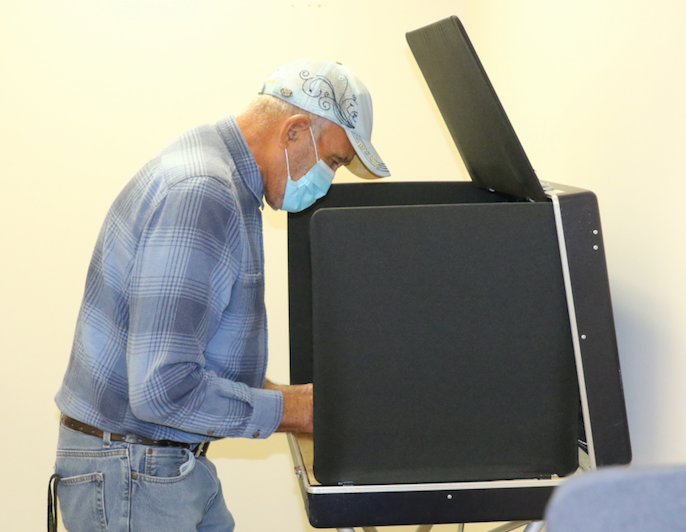Students discuss new routines
Published 6:00 am Wednesday, December 2, 2020
|
Getting your Trinity Audio player ready...
|
It’s been over a month now since Cumberland County Public Schools (CuCPS) students returned to school for in-person classes following nine weeks of virtual learning due to the COVID-19 pandemic.
Many of those students were the first in the area to make a return to the classroom since the global health crisis forced schools to close down in the spring. Three students talked about how virtual learning has changed their routines along with what they like and don’t like about this new way of learning in a pandemic.
Jack McCutcheon, age 17, is an 11th-grade student at Cumberland County High School.
McCutcheon said he always knew a school shutdown was a possibility back in the spring of this year, but never saw the school’s lengthy closure coming.
After spending much of his summer cooped up in the house as the pandemic unfolded, McCutcheon, like all CuCPS students, began his 2020-2021 school year with several weeks of virtual-only classes.
He did well at first, but found he struggled with motivation to do his classwork as the weeks went on.
“I found it hard to prioritize work,” he said. “It was a little rough toward the end.”
When CuCPS Superintendent Dr. Chip Jones informed families in late September that hybrid classes would begin in mid-October, students and their parents faced the tough decision of deciding whether or not to return to in-person classes or continue with virtual-only schoolwork.
For McCutcheon, opting in for hybrid learning seemed like the way to go. He wanted to see some of his friends again and looked forward to some sort of schedule.
For Baylie Robison, age 13, a seventh-grade student in Cumberland County Middle School, hybrid learning was a good option in that it would provide the opportunity to meet and speak with teachers in person, providing some real, in-person interaction that couldn’t be emulated through a laptop screen.
CuCPS currently operates on a hybrid schedule that sees students attending in-person classes four days every two weeks. Split into A and B groups, students attend school Monday-Thursday from approximately 7:45 a.m. to 2 p.m. Friday is used as a deep cleaning day. Students then work from home the following week before returning for their next week of in-person classes.
McCutcheon, who is in the “A” group, said on a typical school day students enter the school building through two doors depending on whether or not they wish to grab breakfast on their way in. After getting temperatures checked, students walk to their homeroom. Some classes are lecture-style, and others serve as work periods to give in-class time to work on assignments.
According to McCutcheon, students still typically walk from classroom to classroom throughout the day, but special emphasis is put upon social distancing as kids traverse across the school building. The halls are divided by lines, and students are instructed to stay to the right and six feet apart. Staircases are all assigned either an upward or downward usage, meaning it can sometimes get a little tedious to take a much longer walk to get to a classroom that’s only the next floor down.
Students sit a minimum of six feet apart from one another at all times, and both kids and teachers are very conscious of respecting one another’s distance.
“We can still talk to our friends around us, but we can’t physically go up in their space,” Robison added.
During school, the only time students may remove their masks is when eating lunch. Students are called in waves to head to the lunchroom to grab their meals before returning to the classroom to eat.
While McCutcheon and Robison typically pack their lunches, Maleeyah Scruggs, age 17, a senior in the B group, will sometimes pick up food from the cafeteria.
Scruggs said keeping six feet of distance means the lunch line can get pretty long at times. Students do not have to touch anything as they make their way through the line, and food service workers will provide condiment packets upon request.
McCutcheon added the school has several sanitization stations, and each classroom has a bottle of hand sanitizer.
“One teacher stands in the hallway and gives everyone a squirt when they walk by, so that’s pretty cool,” he noted.
Students are called in waves for dismissal to board buses or get in their own cars to head home.
Robison, who rides the bus, said students are not allowed to remove their face masks while being transported. Students also must keep their distance from one another while riding the bus, although Robison is able to share seats with her younger siblings.
After a long day at school, the students all make washing their hands a priority as soon as they arrive home.
“I do always go straight to washing my hands,” McCutcheon remarked. “I do feel like I have a lot of germs I need to get rid of.”
Scruggs helps to look after her younger brother by making sure he changes out of his school clothes so that they can be properly washed. Backpacks and school clothes are sprayed with a special fabric disinfectant, and she makes sure she and her brother do not touch school items when not in school.
McCutcheon, Robison and Scruggs, like most students today, have had to cease many of their extracurricular activities due to the coronavirus pandemic.
All three of the students have not been able to participate in sports due to the health crisis. Robison, however, is still able to participate in her band class. During band, students can only remove their masks while playing their instrument, except for percussionists.
The kids have been able to find new hobbies, though. Scruggs picked up new skills during the pandemic, including journaling, drawing and crafting. McCutcheon has been able to follow his passion for cooking and enjoys spending time experimenting in the kitchen.
During “off” weeks when the students are not in the classroom, the day’s schedule can often be self-determined. The hybrid students don’t typically have actual virtual class sessions during their off week, so kids can usually sleep in and use the week to complete homework assignments at their leisure.
“It’s kind of like a 10-day break,” McCutcheon said.
Scruggs, who considers herself a night owl, remarked that she will usually check to see what work her teachers have assigned during the morning in order to determine what assignments she will work on later in the evening.
Robison takes advantage of this schedule by trying to divide her classwork evenly among each week day.
Of course, splitting kids into A and B groups means many students have friends that they do not see regularly due to not being on the same weekly schedule. Staying connected can be tough.
“It is hard, especially now,” McCutcheon said. “You can’t just pop over to a friend’s house.”
Robison, who is in the B group, keeps up with her A-group friends by frequently calling and messaging them to check in. She also tries to find ways to hang out with her friends while staying a safe distance away.
Scruggs said that the majority of her close friends opted out of hybrid learning entirely. She is able to keep up with her friends when they stop by her house, although guests don’t come inside.
Students tend to have mixed feelings about wearing masks. McCutcheon said he isn’t usually bothered by the constant mask wearing, although face coverings can get hot. Robison rips her mask off as soon as she gets home and breathes a sigh of relief.
Scruggs said she hates wearing the masks, which sometimes irritate her skin and leave her winded after a long walk across the high school building.
“But you know, that’s something you have to do,” she said.
McCutcheon and Robison both agreed that their peers in the middle and high schools seem to understand the importance of wearing a mask, adding that the students have taken on a “we’re all in this together” attitude.
All three of the students agreed there are many benefits to in-person learning.
“I get a lot more work done in school, and then I don’t have to take up my time at home. I have time to relax,” McCutcheon said.
Robison and Scruggs agreed in-person learning provides more structure.
When asked what tips they had for students that may soon return to the classroom for the first time since schools were shut down, the students recommended to practice social distancing, to take things one step at a time and to not use the pandemic as an excuse to get behind in schoolwork.
“Just keep your head up,” Robison recommended. “Keep your mask up, too.”





